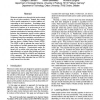Free Online Productivity Tools
i2Speak
i2Symbol
i2OCR
iTex2Img
iWeb2Print
iWeb2Shot
i2Type
iPdf2Split
iPdf2Merge
i2Bopomofo
i2Arabic
i2Style
i2Image
i2PDF
iLatex2Rtf
Sci2ools
IJCAI
2003
2003
Where is ...? Learning and Utilizing Motion Patterns of Persons with Mobile Robots
Whenever people move through their environments they do not move randomly. Instead, they usually follow specific trajectories or motion patterns corresponding to their intentions. Knowledge about such patterns may enable a mobile robot to robustly keep track of persons in its environment or to improve its obstacle avoidance behavior. This paper proposes a technique for learning collections of trajectories that characterize typical motion patterns of persons. Data recorded with laser-range finders is clustered using the expectation maximization algorithm. Based on the result of the clustering process we derive a Hidden Markov Model (HMM). This HMM is able to estimate the current and future positions of multiple persons given knowledge about their intentions. Experimental results obtained with a mobile robot using laser and vision data collected in a typical office building with several persons illustrate the reliability and robustness of the approach. We also demonstrate that our model...
| Added | 31 Oct 2010 |
| Updated | 31 Oct 2010 |
| Type | Conference |
| Year | 2003 |
| Where | IJCAI |
| Authors | Grzegorz Cielniak, Maren Bennewitz, Wolfram Burgard |
Comments (0)

